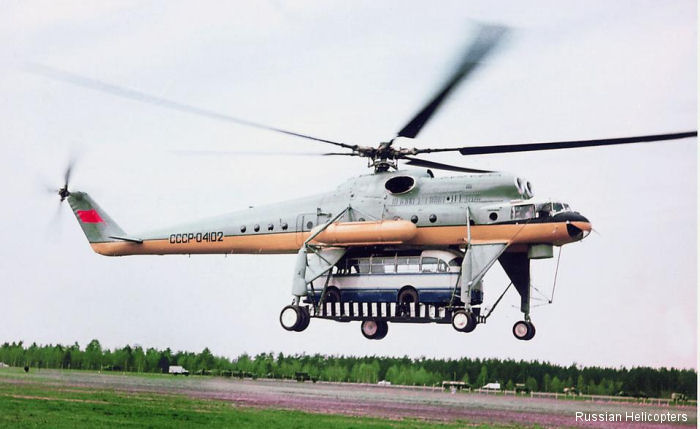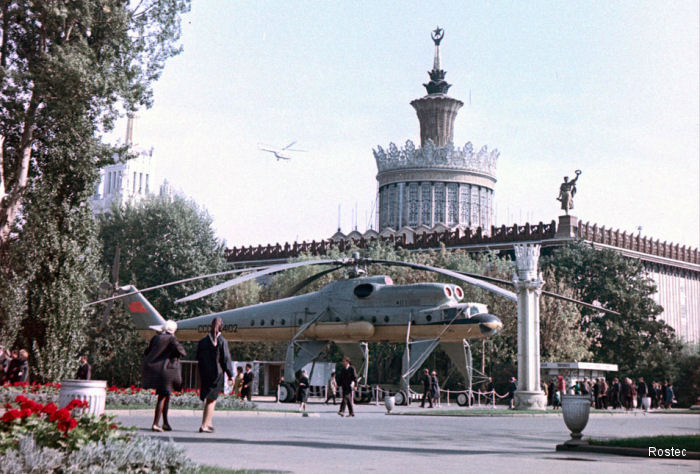Rostec, January 27, 2015 - In January 2015, Russian Helicopters Holding, a subsidiary of the Rostec state-backed corporation, celebrates the 50th anniversary of Mi-10’s world record-setting load-carrying capacity.
In 1965, the Mi-10, piloted by test pilot Raphael Kaprelyan, lifted a weight of 15 tons to a height of 2840 meters, as well as a 5-ton load to 7151 meters.
The Mi-10 is a specialized military transport vehicle, also known as the “letajushchii kran” (the flying crane). The helicopter was produced on the basis of the Mi-6 heavy transport chopper, with maximum use of its parts and components for unification, according to a company press release.
The chopper had a control system and transmission, as well as a power core, similar to the Mi-6, but it differed in its narrow fuselage, original high quadricycle landing gear, allowing room for large loads up to 3.5 meters in height or their lifting up to the platform under the fuselage. After that, hydraulic grips were fastened to the load platform on the landing gear. The Mi-10 had a five-blade main rotor and four-bladed steering.
The development of the aircraft at the M.L. Mile Moscow Helicopter Plant (now part of Russian Helicopters Holding) began in 1958, and in June 1960, the crane-helicopter tested the skies for the first time. Testing on the Mi-10 was completed by 1964, after which Rostov helicopter manufacturers, along with the release of the Mi-6, were tasked with the producing the Mi-10. The first serially manufactured Mi-10 took flight in September 1964.
Subsequently, Rostvertol developed a few modified versions: the Mi-10GR for signals intelligence, the Mi-10UPL for transporting universal field laboratories, and the Mi-10P for fighting frontline aviation by interfering with ground radar early warning and aviation guidance systems. The first two helicopters remained prototypes. The third was more popular: The Mi-10P served along with the helicopters and mixed regiments of the Soviet Air Force. There was another modification of the Mi-10, the “korotkonogaya” (short-legged), which received the designation, Mi-10K. It enjoyed the greatest demand among the country’s transport airlines.
In the USSR, the “flying crane” was used for transport, during installation of drilling rigs in gas and oil producing regions of East Siberia and the Far North, and even for unique installation works in the construction and reconstruction of industrial enterprises. These machines can significantly reduce the time and cost of such works.
In total, Rostvertol manufactured 24 Mi-10 and 21 Mi-10K.
In 1965, the Mi-10, piloted by test pilot Raphael Kaprelyan, lifted a weight of 15 tons to a height of 2840 meters, as well as a 5-ton load to 7151 meters.
The Mi-10 is a specialized military transport vehicle, also known as the “letajushchii kran” (the flying crane). The helicopter was produced on the basis of the Mi-6 heavy transport chopper, with maximum use of its parts and components for unification, according to a company press release.
The chopper had a control system and transmission, as well as a power core, similar to the Mi-6, but it differed in its narrow fuselage, original high quadricycle landing gear, allowing room for large loads up to 3.5 meters in height or their lifting up to the platform under the fuselage. After that, hydraulic grips were fastened to the load platform on the landing gear. The Mi-10 had a five-blade main rotor and four-bladed steering.
The development of the aircraft at the M.L. Mile Moscow Helicopter Plant (now part of Russian Helicopters Holding) began in 1958, and in June 1960, the crane-helicopter tested the skies for the first time. Testing on the Mi-10 was completed by 1964, after which Rostov helicopter manufacturers, along with the release of the Mi-6, were tasked with the producing the Mi-10. The first serially manufactured Mi-10 took flight in September 1964.
Subsequently, Rostvertol developed a few modified versions: the Mi-10GR for signals intelligence, the Mi-10UPL for transporting universal field laboratories, and the Mi-10P for fighting frontline aviation by interfering with ground radar early warning and aviation guidance systems. The first two helicopters remained prototypes. The third was more popular: The Mi-10P served along with the helicopters and mixed regiments of the Soviet Air Force. There was another modification of the Mi-10, the “korotkonogaya” (short-legged), which received the designation, Mi-10K. It enjoyed the greatest demand among the country’s transport airlines.
In the USSR, the “flying crane” was used for transport, during installation of drilling rigs in gas and oil producing regions of East Siberia and the Far North, and even for unique installation works in the construction and reconstruction of industrial enterprises. These machines can significantly reduce the time and cost of such works.
In total, Rostvertol manufactured 24 Mi-10 and 21 Mi-10K.
See also |
Mil Mi-10 Harke






